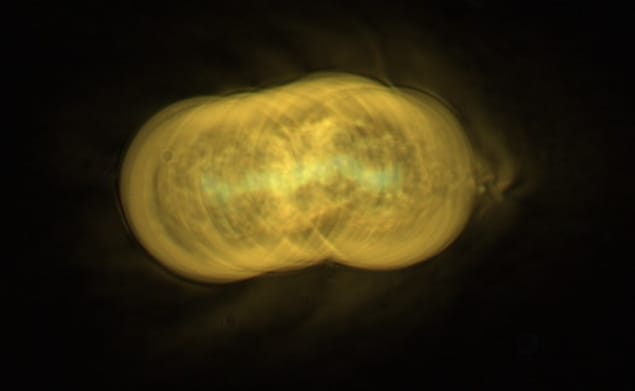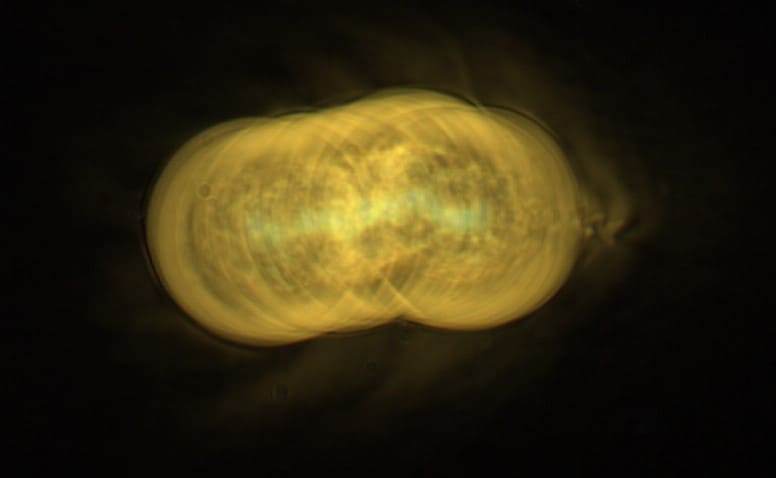
Liquid crystals can be used to direct the motion of self-propelled particles, reveals new research done in the US. In a paper published in Nature, researchers in Oleg Lavrentovich’s group at Kent State University describes how it moved a stabilized droplet of active bacteria along a pre-determined path by harnessing the broken symmetry of a liquid crystal. The researchers found that by aligning the crystal molecules they could force the droplet to move in a straight line, in contrast to its random motion in a Newtonian fluid. It is hoped that this system could be used to model microscopic organisms.
Experimental models are vital to the study of human cell migration and division. Because of their small size, the hydrodynamics of a cell in a fluid is driven by viscosity and sensitive to its diameter, so a successful model must be of a comparable size to the cell of interest. Most experimental active particles such as bacteria are too small to be used as model cells, but they can form a larger active particle when confined inside a droplet.
In this research, the interior of a droplet was filled with Bacillus subtilis bacteria, and its surface was stabilized with surfactant. These “active droplets” are motile, but unlike a cell, which can direct its motion, the droplet follows a random walk and so its displacement averaged over a long period of time is zero. The aim of this research was to extend the active droplet system to create a particle that moves along a fixed path.
Symmetry breaking and liquid crystals
It is the spherical symmetry of an active droplet that ensures it moves randomly, so symmetry breaking is needed to direct its motion. The researchers achieved this by putting the droplet in a liquid crystal.

A liquid crystal that favours molecular alignment (such structures are called nematics) will nevertheless evolve topological defects that persist over large distances. Characteristic defect patterns in the liquid crystal molecule alignment can be created by obstacles and boundaries, such as walls, and in this case the droplets themselves.
Hyperbolic hedgehog
The surfactant forces the liquid crystal molecules into perpendicular alignment with the droplet surface, and this boundary condition competes with the parallel alignment of the molecules at the confining walls. This produces a defect on one side of the droplet called a hyperbolic hedgehog.
To move the droplet on a fixed trajectory, the researchers exploited the non-Newtonian properties of liquid crystals. Like all liquids, a liquid crystal flows when subject to shear stress, but the velocity of the flow depends on the alignment of its molecules.

A shear is provided by bacteria moving together along the inside of the droplet, which occurs at high concentrations, when turbulent vortices form. The liquid crystal outside the droplet begins to flow, and the apolar alignment of the molecules means that the flow is asymmetric. The liquid crystal moves around the droplet away from the hedgehog, resulting in a force that pushes the droplet forwards. This propulsion dominates over viscous drag, with the velocity increasing with particle diameter up to 140 micron, approximately the size of a human egg cell.
Spherical symmetry
For larger droplets, the topological defects become spherically symmetric (resembling Saturn’s rings) causing the droplet to move equally to the left and right. Smaller droplets were also found to be unsuitable for directed motion because they did not contain enough bacteria to form vortices.
In this system, subject to appropriate boundary conditions, the droplet path can be controlled by the alignment of the liquid crystal. The researchers showed this for a liquid crystal where the molecules are aligned in concentric circles and the active droplets follow the alignment in a circular path. The researchers will, in a separate study, investigate the interaction between active droplets in a liquid crystal, where they form chains.
Cell migration underpins biological processes such as tissue repair, embryo development and the spread of cancer. The research demonstrates directed migration of an active droplet, which could make the system a viable model for studying cell movement.
